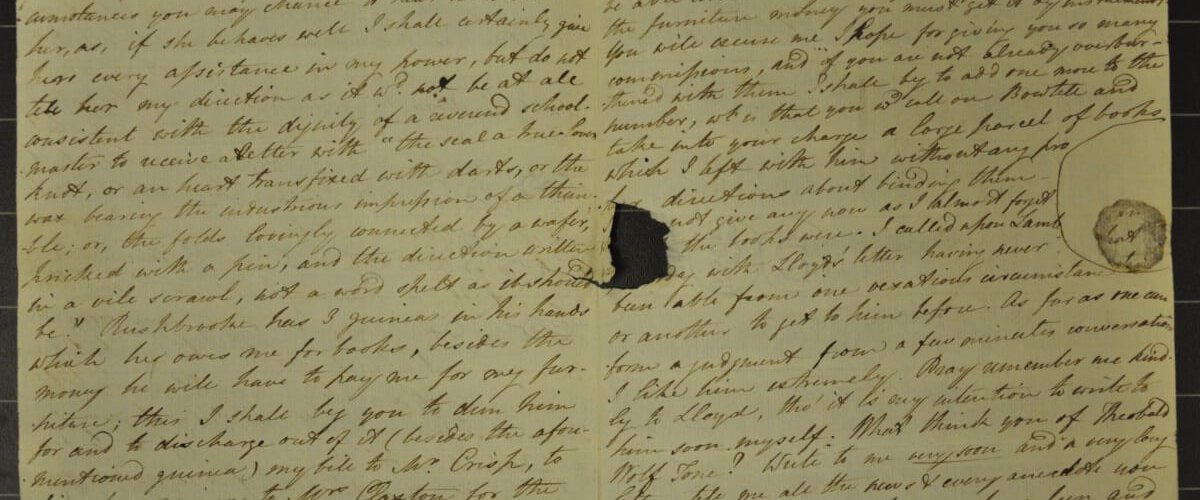On this Day – 15 November
On occasion, when writing a blog post I ally it with an event in history or an international day. However, this week I decided to take a different slant and discover within our collections, items that relate to today’s date, 15 November. With the new archival catalogue it was easy to search for this date and it brought up some interesting results:
On this day in 1790, W. Baines writes to Thomas Manning from Charter House Square, London, This is the period of Manning’s life when he was studying at Cambridge and the letter reflects this and suggests that Baines had also been a Cambridge student (as do Baines’ other letters) but has left to take up employment at Charterhouse school. He writes that Manning has prophesied well and that he does not like the position that he has taken up. But he will continue to Easter or maybe Michaelmas. He wonders if Manning’s Algebra book had been published and asks for the bookseller so he can buy copies. He requests that Manning sort out his outstanding debts in Cambridge and find out about a girl who lived by the Physick Garden. It seems that he wants to help this girl but wants Manning to act as the intermediary as he thinks correspondence from her would not look good coming to a Charterhouse master. As with many young professionals starting out in the world, there is much concern over finance and who owes him money. Baines also writes that he had visited Charles Lamb on the previous day taking a letter from Robert Lloyd and ‘As far as one can form a judgement from a few minutes conversation, I like him extremely’. The full letter can be found on our Digital Library.
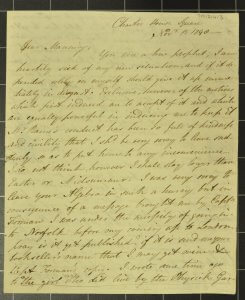
This letter is one of friendship – two young men making their way in the world. The next letter is between two men deeply immersed in Asian studies. On 15 November 1837 Eugène Jacquet wrote to Brian Houghton Hodgson. Eugène Jacquet (1811-1838) was one of the earliest European scholars to make a comprehensive study of the numerical notations in India. He was born in Brussels on 10 May 1811. His family moved to Paris when he was two years old and after an education in Classical Studies he concentrated on eastern studies learning Persian, Arabic, Chinese, and Sanskrit. Eugène Jacquet was introduced to the Société Asiatique, Paris, on 7 September 1829 and he became one of the most active members. On 7 July 1838, he died of exhaustion, with a pencil and a notebook in his hands, amongst the coins sent to him by General Court because Jacquet was recognized as an authority in Indian epigraphy and numismatics. Thus this letter was written only a few months before his death, aged 27 years old. In contrast Brian Houghton Hodgson lived to the ripe old age of 93 years but was only 36 years when this letter was sent to him and was the Resident in Kathmandu. This explains Jacquet’s bemoaning the length of time it takes for letters to pass between them. This letter is the last of a series of letters written by Jacquet between 1934 and 1937 which are collected into an autograph book made by Hodgson’s wife, Susan. This book celebrates the many people whose lives overlapped with Hodgson and who were influenced by him and who, in turn, influenced Hodgson’s career, interests and research. This letter is mainly concerned with discussing manuscripts which Hodgson was finding and sending to the Société Asiatique.
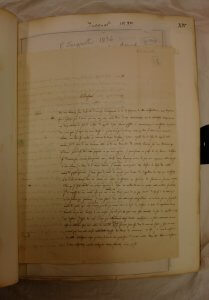
We next fast forward to 1923 when the Society celebrated its centenary. As part of the centenary celebration, a special edition of the Journal was published. On 15 November 1923 the Secretary of Society received a letter from Stephen Austin and Sons, Ltd., Oriental, General and Artistic Printers in which it was noted that the estimate for the production of the edition was acceptable and that the printers will include the two pages of Oriental type at no further cost. It was first decided in 1921 that a Centenary Volume should be produced and at the meeting of the Centenary Committee on 8 February 1921 it was minuted that the model for the Centenary Volume should be that of the Centenary Review of the Asiatic Society of Bengal and should include a history of the Society; quinquennial membership numbers; a list of Presidents, Directors, Honorary Secretaries and Secretaries, and all medallists; a catalogue of the Library and publications undertaken by the Society; a list of authors with their contributions to the Transactions and Journals of the Royal Asiatic Society, with subjects to be subdivided into topics and geographical location; and an alphabetical list of the articles and obituaries within the Journal for which Frederick Eden Pargiter would be the General Editor. By the end of December 1921, the project had been scaled back to the history, list of officers, membership numbers, a brief account of the most important collections and the lists of articles and authors in the Transactions and Journals. The final volume appeared in in this form but without the membership numbers and with the addition of several plates of early illustrious members. In the end the Volume cost more than the original estimate. This was investigated by the Society but Stephen Austin and Sons were found to have charged appropriately for the work undertaken.
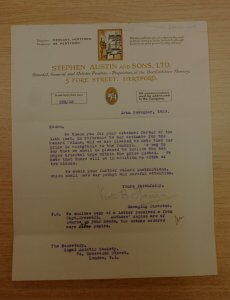
On 15 November 1933, Colonel D.M.F. Hoysted, Secretary of the Royal Asiatic Society, wrote to H.J. Manwaring. From 1904-1929 the Royal Asiatic Society had awarded a Gold Medal to a schoolboy writing on a chosen essay title. However, as entrants dwindled and few schools seemed interested in teaching Indian history, it was decided that the competition should be changed to one for undergraduate students. The change was finalised on 15th December 1931. Regulations for the University Prize Essay Fund were drawn up in 1932 and the first prize was awarded in 1933. In this first letter from Hoysted he asks Manwaring to provide a rough specimen of a suitable diploma for the Universities Prize Essay and a rough specimen for the Diploma of Honorary Membership. A series of correspondence ensues during which Manwaring offers a specimen which is accepted but then seems to not respond to Hoysted’s request to produce the diploma. Unfortunately the papers for the University Prize Essay Fund remains silent as to whether Manwaring successfully completed the task; perhaps a search through the Council Minutes for those interested might resolve the issue.
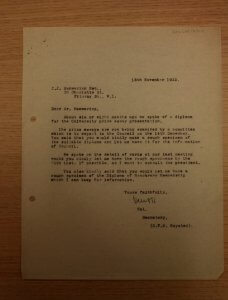
By 1937, the University Prize Essay Fund was in its fifth year. On 15 November 1937, Colonel Hoysted wrote to D.P. Costello to inform Costello that he had been awarded the Universities Essay Prize and to give his congratulations. Hoysted then asks Costello to attend the Society’s General Meeting to receive the award.
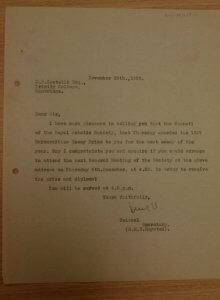
Desmond Patrick Costello went on to have an interesting and controversial life but at the time of submitting his essay he was a Senior Research Fellow at Trinity College, Cambridge and he submitted the essay, The relations between the Greeks and the East; the original essay also being within our archives. However the standard of essay received was high in 1937. Consequently, on 15 November 1937, Colonel Hoysted also wrote to to John Bowman to inform Bowman that his essay had been of such high merit that he would be awarded a copy of The Shah-nameh of Firdausi; the Book of the Persian Kings.
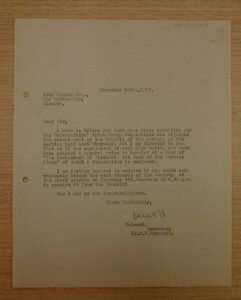
I also discovered items for 15 November in 1965, 1967 and 1989 but at the risk of making this blog over-long, I will leave those for another occasion. If you are intrigued, then go to the archival catalogue, type 15 November into the search box at the top of the page, and all will be revealed.
Nancy Charley, 15 November 2024.

